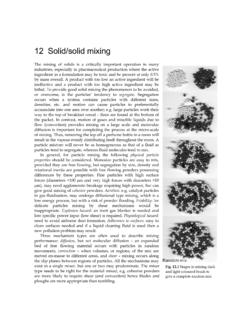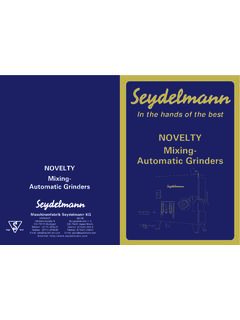Transcription of Mixing and Blending liquids, solids and gases into water ...
1 3/12/20111 Mixing and Blending liquids, solids and gases into water and wastewaterwater and wastewaterAgenda for todays seminar Application of Power to Fluids Formulae Energy Considerations & Applicationsgypp Illustrations & Devices used for Blending Static Mixers and their applications Mixing with Compressed Air or liquid Mechanical Agitator Design Side, Bottom and Submersible Mixers2 Side, Bottom and Submersible Mixers Q&A Wrap Up and CEU Certificates3/12/20112 The first mixer3 Common beginnings Porridge and soups were first mixed from the b tt t bl d th t i t d flf bottom up to blend the nutrients and flavoursfrom the meat into the new additions Poor folks couldn't afford to start a fresh pot every day so they blended the old into the new43/12/20113 Beer and Wine kick start civilization Nomads got tired of travelling after discovering h h b d d the secret honey bee tree and mead sucrose & yeast = relaxation The success of herding and
2 Hunting gave way to agriculture and vegetarians. Next thing you know they all want universal health care and free college tuition5health care and free college tuitionGovernment takes hold Soon more and more nomads came to the city f f b d ifor free beer and wine Taxes were levied to pay for the wheat and barley and grapes Houses had to be built to protect the people .. mortar and mud mixers were invented to augment the wooden paddle used by the 6augment the wooden paddle used by the brewers and cooks3/12/20114 Mixing 101 History Food processing, mining, pulp & paper , cosmetics, pharmaceuticals, petroleum, power cosmetics, pharmaceuticals, petroleum, power and chemical processing industries developed unique impellers for many Many were for batch processes & simple Blending of 2-3 components Continuous flow processes require some difft t f it ti7different types of agitationMixing Pictures In order to choose the right equipment.
3 You need to understand the Mixing needs and time need to understand the Mixing needs and time frame. Develop a visual image of what needs to be done to satisfy the process goal Place your application into a Mixing class to start the process of selection83/12/201155 Application Classes liquid solid liquid -Gas liquid -Gas Miscible Liquids Immiscible Liquids Fluid Motion9 liquid - solid Dissolving a solid into a liquid Suspending solids off bottom Suspending solids off bottom Describe the solids powders,rocks,dense,fluffy,sticky,crysta ls Describe the power needed- just off bottom, way up the tank til reaction or complete uniformity for continuous pumping to another 10tank3/12/20116 Gas liquid Dispersion of a gas into a liquid Absorption of a liquid into a gas Describe the density and viscosity of the liquid to understand power needs Describe the amount of miscibility the gas has in the liquid .
4 Whether it takes along time to effect mass transfer or if it's easy11effect mass transfer or if it s easyImmiscible Liquids Explain the two components or more and their viscosities and rheologies varyviscosities and rheologies vary Is it a blend like salad dressing or a finished end product like mayonaaissee or and drop size data Is it a mass transfer operation like hexane decaffinization of coffee or solvent extraction f il12from Is it Mixing polymer into water for flocculation or dewatering3/12/20117 Fluid Motion Describe pumping capacity of impeller and bl d i i dblend time required Explain the inlet and outlet port locations and side forces if velocities are high Is their heat transfer to accomplish like Mixing cold water and warm water Is it chlorine contact chamber Blending before 13 Is it chlorine contact chamber Blending before a CT tank ?
5 Tank and Impeller concepts The perfect tank is a cube so describe how diff i different your requirements Tall and skinny, fat and short, round with conical bottoms, horizontal with a long side ratio ? Is it above ground , below egress an issue, can you get to the mixer for 14issue, can you get to the mixer for or not ? Concrete , glass, FRP, stainless or steel ???3/12/20118 Impellers or is it non-contact Radial flow impellers pump out from the tips d h k lltoward the tank walls Axial flow impellers pump down from the turbine or up toward the top Can you use a motive liquid stream or air to blend instead of sticking metal parts into the tank ?
6 15tank ?Tank Geometry Need height, length and width or diameter Open or closed top Side bottom or top entry point Injector locations Mixer location center or offcenter Mixer angle for vortexing or not16 Baffle locations if Requirement 10 minute blend time or 30 seconds Uniform temp at outlet within 30 min pH within +/- log Conductivity or dissolved solids concentration Streaming current value stable UV level correct17 Feed Characteristics Density or specific gravity of components Te m p e ra t u r e Viscosity Corrosivity / pH level Volume ratios % solids level18 Settleability %Volatile solids Ash content3/12/201110 Degree of Mixing Mild, moderate or violent How to define these terms, swirling , splashing moving rippling, How about a Scale from 1-10 Call it Chemscale & define it a the range from 6-60 feet per minuteB lk Fl id V l it t k ti f 19 Bulk Fluid Velocity ~ tank motion for many turbulent flow applicationsComputational Fluid Mechanics CFM is a powerful tool that is used to mathematically model fluid flows of different agitator/impeller designs in Mixing tanks.
7 Mixing of single and multi-phase fluids in stirred tank reactors is a common operation in many industries. Understanding the fluid flow in these tanks is critical for equipment design, scale-up, process control and economic factors. CFM models allow you to see what is taking place in the Mixing vessel. The results enable an engineer to select the best agitator design to bt i th d i d f20obtain the desired process performance. Rectangular and side-entering agitated tanks as well as turbulent and laminar flow static mixers can all be successfully evaluated3/12/201111 Graphic Analysis21 Digital Particle Image Velocimetry (DPIV) An Argon-Ion laser light sheet illuminates fluorescent, neutrally buoyant particles.
8 A CCD camera captures the images, then an advanced timing system and a computer with image board freezes and digitizes the system and a computer with image board freezes and digitizes the images. The picture below shows the motion of fluorescent particles illuminated by a sheet of Argon-Ion laser light. The particles (60 micrometers) are small and neutrally buoyant, so they follow the liquid flow. The tank is equipped with a pitched-blade turbine. The particle motion is filmed with a CCD camera. The velocity field is then extracted from the digitized images using cross-correlation software. Armed with this information, engineers can better design agitators.
9 DPIV technology has the capability of measuring the entire fluid velocity field in a tank almost instantaneo sl making it possible to st d la ge22field in a tank almost instantaneously making it possible to study large-scale, time-dependent phenomena in the tank. The color shows the local, time-averaged velocity. Fast-moving regions are colored red and slow-moving regions are colored blue. The pitched-blade turbine creates a mixed axial/radial flow pattern. The highest velocities are found at the impeller blade tip. The velocities at the liquid surface are an order of magnitude images23 DPIV graph243/12/201113 Laser Doppler Anemometry (LDA) is widely recognized as the best method of non-intrusively determining mean velocity and turbulence data with pinpoint accuracy using the DantecFlowLiteturnkey measurement system to determine using the DantecFlowLiteturnkey measurement system to determine velocities in stirred tanks and static mixers.
10 The measurement technique relies on the physical fact that when two laser beams of the same wavelength cross, an interference pattern of bright and dark fringes is formed. As a single particle passes through the intersection of two such laser beams, it reflects light at certain frequencies which depends only on the velocity of the particle and the fringe spacing. Appropriate optical collection and data analysis enable highly accurate 25velocity measurements within extremely small volumes of fluid. Within minutes, thousands of particles may pass through the measurement volume, enabling an accurate determination of velocity at that pointLaser Doppler Anemometry263/12/201114 Laser Induced Fluorescence One of the most challenging problems in fundamental diagnostics is directly measuring mixedness.







